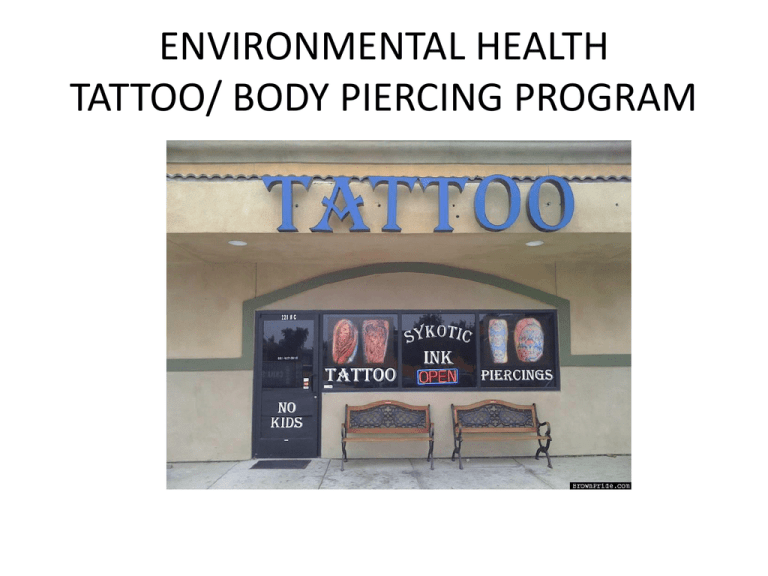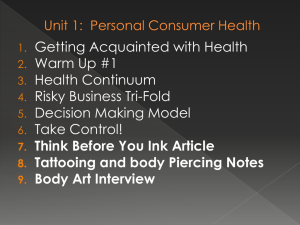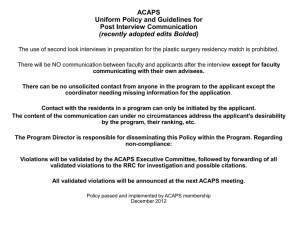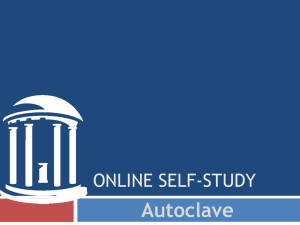Tattoo Critical Items Presentation
advertisement

ENVIRONMENTAL HEALTH TATTOO/ BODY PIERCING PROGRAM Tattoo & Body Piercing Definition/Establishments/ Inspections Tattoo means any method of placing designs, letters, figures, symbols, cosmetics or any other marks under the skin of a person with ink or color by the aid of needles or instruments. There are 409 tattoo establishments in the state Each requires four(4) inspections per year. Body Piercing means the piercing of any part of the body for compensation by someone, other than a physician licensed under title 63, who utilizes a needle or other instrument for the purpose of inserting an object into the body for non-medical purposes; body piercing includes ear piercing except when the ear piercing procedure is performed on the ear with an ear piercing gun. There are 231 establishments statewide . Each of these requires one(1) inspection per year. CRITICAL ITEMS (VIOLATIONS) TATTOO PROGRAM CRITICAL ITEMS (VIOLATIONS) Definition: Means those aspects of operation or conditions which, if in violation, constitute the greatest hazards to health and safety, including imminent health hazards. IMMINENT HEALTH HAZARDS Definition: “any condition, deficiency, or practice . . . which, if not corrected, is very likely to result in illness, injury, or loss of life.” IMMINENT HEALTH HAZARDS ARE CRITICAL ITEMS THAT MAY RESULT IN THE IMMEDIATE CESSATION OF OPERATIONS. IMMINENT HEALTH HAZARDS Examples of Imminent Health Hazards – A. AUTOCLAVE NOT WORKING AND NO STERILE NEEDLES OR BARRELS AVAILABLE. B. NO POTABLE WATER AVAILABLE. C. SEWAGE OVERFLOW OR BACKED UP IN ESTABLISHMENT CRITICAL ITEMS (VIOLATIONS) • Item 4 – Autoclave meets minimum time, temperature, pressure. 250° F 15 psi 15 min. AUTOCLAVES THAT YOU MAY ENCOUNTER 2540M 2540M Tuttnauer TUTTNAUER Autoclave AUTOCLAVE 2100 Classic Autoclave CRITICAL ITEMS (VIOLATIONS) Item 6 – Water source approved, hot and cold under pressure. A sink (hand or utensil) with hot and cold running water for handwashing and sterilization, in addition to the bathroom sink. CRITICAL ITEMS (VIOLATIONS) Item 7 – Sewage and liquid waste disposal. CRITICAL ITEMS (VIOLATIONS) Item 9 – Cross-connection, backflow, back siphonage. Cross-connections: existing or potential connections between potable (drinking) water and sewage or other hazards. CRITICAL ITEMS (VIOLATIONS) • Item 10-Installed, designed, number, convenient, available • A hand basin is required in the restroom; one or more must be convenient to all work stations. Basins must be accessible, convenient, and without extraneous items in the basin. • SOME WORK ROOM CONFIGURATIONS MAY REQUIRE MORE THAN ONE BASIN CRITICAL ITEMS (VIOLATIONS) • Item 13- Presence/evidence of insects, rodents, harborage— outer openings protected • Check around doors and windows; also around conduits, pipes, wires, and other items penetrating building’s exterior walls. OUTSIDE OPENINGS (DOORS, WINDOWS, VENTS, CONDUITS, ETC.) MUST HAVE GAPS LESS THAN ¼ INCH. EXTERIOR DOORS MUST REMAIN CLOSED CRITICAL ITEMS (VIOLATIONS) • Critical Item 21- Toxic items stored, labeled, used. • Toxic items must be properly labeled, stored, and used. Proper labeling means the common name or use in legible English; ie. “window cleaner”. CRITICAL ITEMS (VIOLATIONS) • Critical Item 21- No reuse of single use articles Definition: A disposable item that is used one (1) time on one (1) client and then is properly disposed of by appropriate measures. CRITICAL ITEMS (VIOLATIONS) • Critical Item 21- No reuse of single use articles ITEMS DESIGNED FOR SINGLE-USE DYES, DYE CUPS, GLOVES, NEEDLES, OINTMENTS, PAPER TOWELS, PLASTIC BARRELS, STENCILS, MARKING PENS, TONGUE DEPRESSORS, ULTRASONIC SOLUTIONS & CUPS , DISPOSAL RAZORS, etc. CRITICAL ITEMS (VIOLATIONS) • Critical Item 27- Good hygienic practices, proper handwashing. • Wash hands often and properly • Lather for at least 20 sec. • Avoid excessive jewelry CRITICAL ITEMS (VIOLATIONS) • Critical Item 27- Good hygienic practices, proper handwashing ME “Double Handwashing” means that hands are washed both in the restroom and also on returning to the workroom (area). CRITICAL ITEMS (VIOLATIONS) • Critical Item 27- Good hygienic practices, proper handwashing • Smoking • Eating • Drinking CRITICAL ITEMS (VIOLATIONS) • Critical Item 29- Employees with infectious lesions on hands restricted from tattooing • Artists and piercers with hand lesions may not perform procedures. CRITICAL ITEMS (VIOLATIONS) • Critical Item 30- Monthly microbiological monitoring tests • • TATTOO: Done monthly. PIERCING: Done weekly. • Spore testing is done using a known bacterial species. The sample is run during a normal autoclave cycle and sent off to be processed by an independent, licensed laboratory. Spore testing may not be done “in house.” “Positive” samples require that another spore test be done; a second “positive” sample requires notifying the Health Dept. CRITICAL ITEMS (VIOLATIONS) • Critical Item 31- Tubes and needles sterilized in an approved manner. Equipment sterilized for not more than one (1) year. • Only an autoclave is approved for final on-site sterilization. CRITICAL ITEMS (VIOLATIONS) • Critical Item 31- Tubes and needles sterilized in an approved manner. Equipment sterilized for not more than one (1) year. Autoclaved items must be properly dated; storage time cannot exceed one year. CRITICAL ITEMS (VIOLATIONS) • Critical Item 32- Work room equipped and restocked as required • **SIX (6) STERILIZED NEEDLES, NEEDLE BARS, AND BARRELS • **ONE (1) EXTRA PACKAGE OF DISPOSABLE TOWELS • **ONE (1) EXTRA BOX OF DISPOSABLE GLOVES • **EXTRA SUPPLIES OF BANDAGES, ANTIBACTERIAL SOAP, OINTMENTS, AND GELS CRITICAL ITEMS (VIOLATIONS) • Critical Item 33- Sterile instruments properly handled • Several Problems -Unrestrained Hair -Assembly of instruments without gloves -Barrel and Q-Tips laying on paper towels CRITICAL ITEMS (VIOLATIONS) • Critical Item 34- Reusable instruments properly handled • Reusable items must be properly handled; for example, tattoo barrels must be disinfected before handling.










